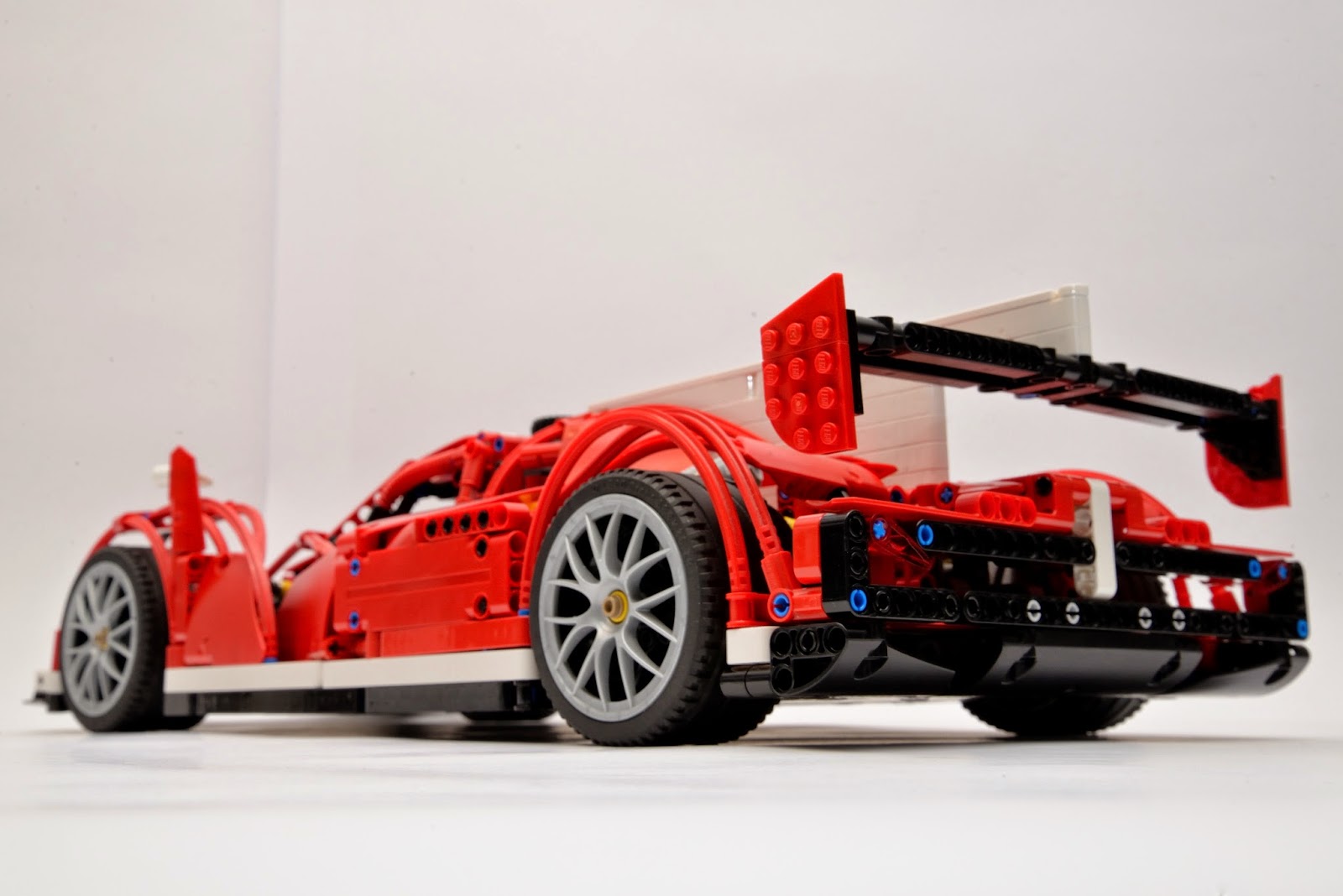- Technic MOC
- Started January 2015
- Completed March 2015
- 1492 parts.
- Instructions available here.
Here are the specifications for the contest:
- from 1100 to 1500 parts
- 4 independant suspensions, steering and a transmission to the back wheels from a fake V8 engine
- a removable bonnet at the back (manual or with a mechanism)
- independant doors (manual or with a mechanism)
- the car must be a closed cockpit LMP1
- no old style technic panels allowed
- no more functions than the 42039.
Functions
Despite not being its primary function, the car has great playability, with the help of a few nice functions.
Each wheel is independently suspended with a pushrod suspension. This design has been chosen for two reasons: it gives a low deflection (an LMP1 car effectively needs very little) and it's more pleasing to the eye than regular suspension.
Each axle has been tailored to include the other necessary functions:
- At the front, the pushrods are close to the center of the car, to allow the wheel to turn. Steering is achieved via a HOG on top of the cockpit and via the steering wheel inside.
- At the back, the pushrods are as close to the wheel as possible, to make room for the differential in the center. A fake V8 is connected to the back wheels through the following gears : Diff to 20t > 12t to 20t > V8. The same ratio as in the 42039 is achieved, giving a nice speed to the pistons when you move the car around.
The doors open independently with a lever located behind the cockpit. The system is similar to the one featured in the #8653 Ferrari Enzo: dampened springs are maintained compressed when the doors are closed and released when the lever is pulled, slowly opening the doors. Just push the lever back into position to close the doors.
The bonnet can be lifted to access the engine bay. It is held in place via axle pins in front of the back wheels and a 90° connector stuck between a pin joiner and a panel at the back.
The following video shows the functions in action.
Design
Being the key aspect of this contest, the design has been meticulously taken care of.
It's not based on any current or past existing LMP1 cars, but it takes a few details from some of them.
The car is mostly red, with a black underside and spoiler, and a white stripe on each side and in the center. The color has been chosen according to my stock of parts, which contains a lot of red flex parts from Ferrari Racers sets.
The front splitter is raised in the middle, as on most current LMP1 cars. The nose is inspired from the one of the Peugeot 908, with the two parts connecting the nose to the splitter.
The lights are each composed of four projectors on a black background, sitting on top of the white stripe. A black flex part makes them pop from the wing.
The front mudguards are mostly composed of flex parts, to get the right shape. They are deliberately separated from the rest of the body, as on the Peugeot. An air canal is then formed between the body and the mudguards, keeping the car stable and supplying the front brakes and some of the back radiators with cool air, through that canal. Multiple panels help create that canal on either side.
The cockpit has a round windshield composed of two flex parts and two half-beams. It gives a very nice shape to it. The doors and door pillars are slanted, so that they open upwards.
The inside of the cockpit has also been taken care of. In addition to a functional steering wheel, the dashboard contains two dials and LEDs to tell the driver when to change gear, on top of the steering wheel. The seat is very much like a real one, as it raises at the legs.

The bonnet is pretty much the half back of the car's body. All of it can be lifted to access the engine bay. On top of the bonnet sits the shark fin, all in white, with the spoiler at the end. I tried a few options, but the stacking of liftarms is still the best looking one, in my opinion.
The sides are mostly made of panels to fill the gaps and make nice curves.

The engine bay is simple, with the engine and the tubes leading to the exhausts, on each side.
The back mudguards are also made of flex parts, to get the right shape. The body then smoothly ends with backwards curved 5x11 panels.
Unlike the #42039, the back of the car is like any current LMP1 car: it looks like it was laser cut. The liftarms are put hole-side out to give this impression.

The underside of the car is as flat as possible. Naturally, it uses a lot of 5x11 panels.

Conclusion
This contest was fun. This was my first time doing real design on a MOC and it was very interesting. I already have a few other projects for cars that I now know I can do.
Instructions are freely available for download here.
More pictures :







































No comments:
Post a Comment